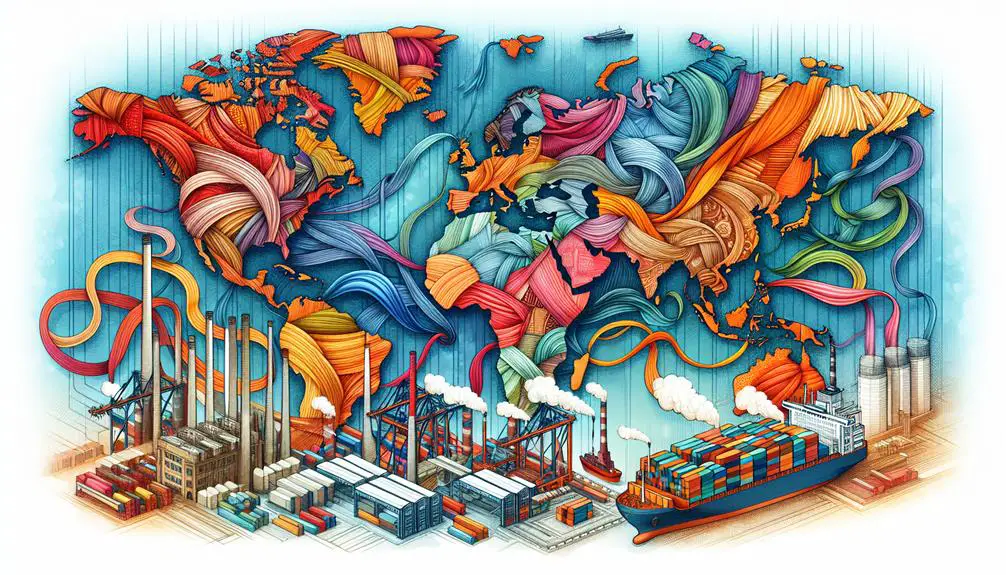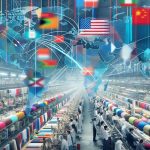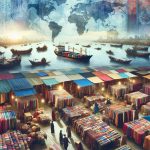Handling trade policies in the textile industry can feel like walking through a maze with shifting walls. You deal with tariffs and duties that hike up costs, making it harder to price competitively. Quotas and import limits further complicate things by controlling supply and availability. Free Trade Agreements might offer some relief, reducing barriers and opening markets. However, protectionist measures and trade wars add another layer of unpredictability. So, how do you adapt your strategies to stay ahead in such a volatile environment? Let's explore the intricacies and find out.
Table of Contents
Key Takeaways
- Tariffs and duties shape competitive dynamics and influence business decisions in the textile industry.
- Free Trade Agreements reduce tariffs, simplify customs, and enhance market access for textiles.
- Quotas and import limits affect the supply and pricing of imported textile products.
- Protectionist measures, like import restrictions, aim to protect domestic industries but can lead to higher prices.
- Trade wars disrupt supply chains, pricing strategies, and global market positioning in the textile industry.
Tariffs and Duties
Tariffs and duties play an essential role in shaping the competitive landscape of the textile industry. If you're looking to navigate this complex environment effectively, understanding how these financial impositions affect your bottom line is vital.
Tariff exemptions can offer significant advantages, allowing certain imported textile products to enter a market without the added financial burden of tariffs. Knowing which products qualify for these exemptions can save you substantial costs and give you a competitive edge.
Understanding duty rates is equally important. These rates vary depending on the type of textile product and its country of origin. Higher duty rates can make imported textiles less competitive compared to locally produced alternatives. You need to stay informed about current duty rates to make well-informed business decisions.
For instance, leveraging Free Trade Agreements (FTAs) can sometimes reduce or eliminate duty rates on specific textile imports, enhancing your market positioning.
Quotas and Import Limits
Quotas and import limits serve as critical regulatory tools that can drastically affect the availability and pricing of textile products in the market. By capping the amount of foreign textiles allowed into a country, these trade restrictions can shield domestic industries from global competition.
You'll notice that when quotas are in place, the supply of imported textiles is limited, often leading to higher prices for these goods. This protects local manufacturers by reducing the pressure to compete with lower-cost imports.
Import limits can also stabilize the domestic market by preventing an influx of cheap textiles that could drive local businesses out of the market. However, they can also lead to inefficiencies. When you restrict imports, it could mean that local producers face less incentive to innovate or improve their processes, potentially leading to higher prices for consumers.
Navigating quotas and import limits requires a keen understanding of international trade dynamics. You need to stay updated on changing regulations and monitor how these trade restrictions affect both your supply chain and market competitiveness.
Free Trade Agreements
Free trade agreements frequently reshape the textile industry by eliminating barriers and promoting easier access to international markets. When countries sign these agreements, they often experience significant benefits, such as improved market access and better regulatory alignment. As a textile professional, you can leverage these advantages to expand your business and streamline operations.
Consider how decreased tariffs and simplified customs procedures can lower costs and facilitate quicker entry into new markets. This not only improves your competitiveness but also allows you to diversify your supply chains. Regulatory alignment guarantees that standards and practices are more uniform across borders, reducing the complexity of compliance and enhancing efficiency.
Here's a quick overview of the benefits:
| Benefit | Impact on Textile Industry |
|---|---|
| Enhanced Market Access | Unlocks new opportunities and increases sales potential. |
| Reduced Tariffs | Reduces costs, making products more competitive. |
| Regulatory Alignment | Streamlines compliance, enhancing operational efficiency. |
Protectionist Measures
Protectionist measures, such as import restrictions and subsidies for domestic producers, can disrupt the global textile industry to a large extent. By imposing tariffs and quotas, these policies often aim to shield domestic industries from foreign competition. While this might seem beneficial in the short term, you should consider the broader economic impact on the global market. Protectionist tactics can lead to higher prices for consumers and retaliatory actions from other countries, complicating international trade relations.
You might think that protecting local jobs is a valid reason for implementing these measures, but the reality is more complex. While some jobs may be saved initially, the industry growth can stagnate due to a lack of competition. Domestic producers may lack the incentive to innovate or improve efficiency, leading to long-term job loss as the industry becomes less competitive globally.
Moreover, when other countries impose their own protectionist measures in response, it can create a ripple effect throughout the global market. This can stifle international trade and cooperation, harming not just individual economies but the textile industry as a whole. You must weigh these potential downsides carefully before advocating for protectionist policies.
Trade Wars and Disputes
Trade wars and disputes can disrupt the textile industry, impacting everything from supply chains to pricing strategies. When countries impose tariffs or sanctions on each other, textile firms often bear the brunt. You'll notice immediate supply chain disruptions, as raw materials and finished goods face delays or increased costs. This volatility can wreak havoc on your market positioning and pricing models, forcing you to scramble for alternatives.
Economic consequences of trade wars extend beyond just the affected countries. They've global implications, causing ripples in markets worldwide. You might find that your traditional suppliers are no longer viable, pushing you to forge new relationships, often at higher costs. The market volatility can also affect consumer confidence, reducing demand just when you need stability.
In maneuvering through these turbulent waters, strategic agility becomes vital. You should invest in diversifying your supply chain to mitigate risks. Also, staying abreast of policy changes can give you a competitive edge. By understanding the broader economic consequences and preparing for their global implications, you can better position your business to weather the storm. In this high-stakes game, adaptability isn't just an asset; it's a necessity.
Future Trends and Predictions
Looking ahead, you should anticipate a shift towards sustainable and ethical practices in the textile industry. As consumers demand more eco-friendly products, companies will need to adopt sustainable practices to stay competitive. This means integrating organic materials, reducing waste, and ensuring fair labor practices.
Technological advancements will play a pivotal role in this transformation. Innovations like automated manufacturing, AI-driven quality control, and blockchain for supply chain transparency will enhance efficiency and accountability.
You'll see smart textiles that not only reduce environmental impact but also offer new functionalities, such as temperature regulation and health monitoring.
Trade policies will likely evolve to support these trends. Expect stricter regulations on carbon emissions and incentives for companies that meet sustainability criteria. Governments may impose tariffs on non-compliant products, pushing the industry towards greener alternatives.
You should also be prepared for increased international collaboration. Countries might form alliances to promote ethical standards and share technological advancements. This global approach can lead to more uniform regulations and reduced trade barriers, fostering a more sustainable and equitable industry.
Frequently Asked Questions
How Do Trade Policies Impact Textile Industry Workers' Wages and Employment?
You'll notice trade agreements and tariffs directly influence labor conditions and job security. These policies dictate wage levels and employment stability, making it important for you to understand their impact on the textile industry's workforce.
What Environmental Regulations Affect the Global Textile Trade?
You should understand that environmental regulations affecting the global textile trade focus on reducing carbon emissions and promoting sustainability. They also address water usage and pollution, ensuring the industry's practices are environmentally responsible and sustainable.
How Does Intellectual Property Law Influence Textile Design and Innovation?
Imagine a tapestry woven with creativity; intellectual property law is the loom. You'll find copyright protection shields your textile designs, preventing design infringement and fostering a fertile ground for innovation and artistic growth.
What Role Do Supply Chain Logistics Play in Textile Trade?
You must master supply chain logistics for efficient textile trade. Efficiency optimization streamlines processes, while inventory management guarantees the right stock levels. This balance reduces costs and enhances your competitive edge in the market.
How Do Currency Exchange Rates Impact Textile Export and Import Costs?
When you navigate the delicate dance of exchange rates, you'll find they subtly influence your textile export and import costs. These rates can turn production costs into a manageable challenge or an unexpected boon, impacting your bottom line.
- How Does Ring Spun Cotton Affect Garment Fit and Shape Retention? - August 13, 2024
- What Are the Challenges in Producing Ring Spun Cotton? - August 13, 2024
- Is Ring Spun Cotton Suitable for Plus-Size Clothing? - August 13, 2024







